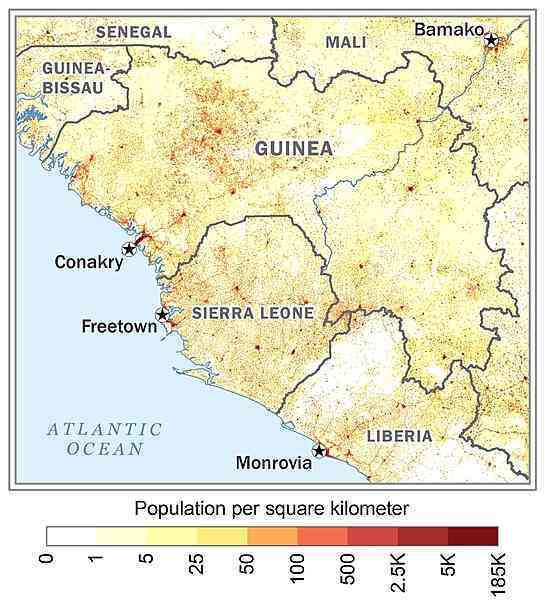
Western Africa, bordering the North Atlantic Ocean, between Guinea-Bissau and Sierra Leone
11 00 N, 10 00 W
Africa
total: 245,857 sq km
land: 245,717 sq km
water: 140 sq km
slightly smaller than Oregon; slightly larger than twice the size of Pennsylvania
total: 4,046 km
border countries (6): Cote d'Ivoire 816 km; Guinea-Bissau 421 km; Liberia 590 km; Mali 1062 km; Senegal 363 km; Sierra Leone 794 km
320 km
territorial sea: 12 nm
exclusive economic zone: 200 nm
generally hot and humid; monsoonal-type rainy season (June to November) with southwesterly winds; dry season (December to May) with northeasterly harmattan winds
generally flat coastal plain, hilly to mountainous interior
highest point: Mont Nimba 1,752 m
lowest point: Atlantic Ocean 0 m
mean elevation: 472 m
bauxite, iron ore, diamonds, gold, uranium, hydropower, fish, salt
agricultural land: 58.1% (2018 est.)
arable land: 11.8% (2018 est.)
permanent crops: 2.8% (2018 est.)
permanent pasture: 43.5% (2018 est.)
forest: 26.5% (2018 est.)
other: 15.4% (2018 est.)
950 sq km (2012)
Niger river source (shared with Mali, and Nigeria [m]) - 4,200 km; Gambie (Gambia) river source (shared with Senegal and The Gambia [m]) - 1,094 km
note – [s] after country name indicates river source; [m] after country name indicates river mouth
Atlantic Ocean drainage: Niger (2,261,741 sq km), Senegal (456,397 sq km)
areas of highest density are in the west and south; interior is sparsely populated as shown in this 
hot, dry, dusty harmattan haze may reduce visibility during dry season
the Niger and its important tributary the Milo River have their sources in the Guinean highlands
NOTE: The information regarding Guinea on this page is re-published from the 2024 World Fact Book of the United States Central Intelligence Agency and other sources. No claims are made regarding the accuracy of Guinea 2024 information contained here. All suggestions for corrections of any errors about Guinea 2024 should be addressed to the CIA or the source cited on each page.
This page was last modified 04 May 24, Copyright © 2024 ITA all rights reserved.